“A queer country, so old that, as you walk on and on, there is a feeling comes over you, that you are gone back to genesis.” (Bushman, Bushman)
A moment of crisis turned into a new adventure
The COVID-19 pandemic turns out to be one of the deadliest pandemics in world history. However, for us, the pandemic marked the beginning of a new long adventure across Oceania. On March 23rd, 2020, when our return flights from New Zealand got canceled, as most countries were shutting down their borders in an attempt to contain the deadly SARS-COV-2 virus, we decided to stay put and transform what appeared to be a moment of crisis into a new adventure across New Zealand and beyond. Thus, what we thought would be a two weeks experience in New Zealand, turned out into a full on expedition across the entire New Zealand archipelago and beyond.
So, what could you do in the middle of a pandemic better than walking over 1.700 km across The North Island of New Zealand, cycling another 1.500 km across The South Island and then walk another 100 km across the much smaller Stewart Island? As it turns out, when we emerged from a five weeks long hard lockdown in the small town of Kerikeri, in the Northland region of New Zealand, we found ourselves in a pretty much COVID free country that stayed this way for most of 2020 and the first half of 2021, allowing us to explore some of the most amazing landscapes across the country in a safe way. But, as our adventure was finally coming to an end, returning home wasn’t an option for us. This is why we started contemplating the much bigger, wilder and challenging “neighbouring” Australia. You know how it goes. Once you get started, it’s almost impossible to stop. On the other hand, if up until that point the entire trip has been very spontaneous, with very little preparations needed, we knew that Australia would be a different story. If we were to tackle the vast Australian outback, in any way, we needed to get well prepared.
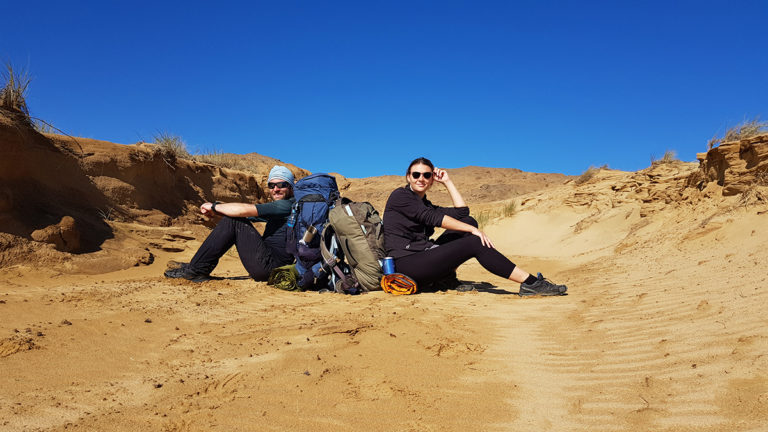
I have been riding a two wheels push bike for years, cycling parts of Europe, the length of the Americas and parts of New Zealand. For Irina, though, cycle touring was quite a new thing when we set out to cycle the South Island of New Zealand and to be honest, she never really got to fully enjoy it as much as I do, at least not on a two wheels pushbike. I wanted to cycle around Australia and we both contemplated this plan at the end of our New Zealand journey, but since Irina excluded the possibility of a regular two wheels pushbike we had to find an alternative. This is how we stumbled upon the idea of riding two recumbent tricycles. Easier said than done, since, on top of that, Irina wanted hers to be electrically assisted. As we were doing our research we found out about the Sun Trip and this was probably the biggest source of inspiration for building her solar powered tricycle as, to be honest, there is not much information available about building one and is not something that you can buy ready made off the shelf.
From the very beginning AZUB was on our top list of choices for the tricycles and we have researched pretty much all other major manufacturers (there aren’t that many anyways given that the recumbent tricycles market is quite a small one with around 50.000 sold yearly worldwide). So, I downloaded the AZUB yearly catalogue one day and as I was browsing through its pages I came to the section dedicated to other adventurers that AZUB sponsors and writes about. Soon enough, I was in a Skype call with Honza Galla from the marketing department and we immediately clicked. Honza liked our idea of cycling around Australia and so AZUB became one of our main partners in this adventure. We decided to get two different trike models. Irina opted for the ultra sophisticated Ti-Fly 26 and I opted for the ultra simple T-Tris 26. I usually go for the simplest of models. I believe in simplicity, whereas Irina wanted something that she could convert to solar and ride with a peace of mind through the outback corrugated roads of Australia. Due to the fact that important parts of our itinerary were to be on unsealed roads, we both opted for the 26 inch rear wheels.
For a period of a couple of months, between April and June of 2021, New Zealand and Australia opened for the first time since the beginning of the pandemic their borders in a so called quarantine free Trans-Tasman Bubble, while still maintaining them closed for the rest of the world. Up until that point, both countries have kept their borders shut to the rest of the world, in an attempt to limit the spread of the COVID virus. They had implemented a strict quarantine management system for their own residents and citizens returning from overseas, which, up until a point, was effective in keeping the number of cases very low and maintaining an almost pre-pandemic normality in the day to day life for those of us who found ourselves in this part of the world. This is when we decided to book a ticket for Sydney and make the next move.
Australia, here we come!
It was June 10th and this was the first time that we were flying internationally since the beginning of the pandemic. With seatbelts and masks on, we soon left the snowy peaks of the Southern Alps behind and flew over the Tasman Sea into Sydney, Australia’s largest city, known worldwide for its emblematic Sydney Opera House and its buzzing harbour. We had a few months ahead to get everything ready and rolling. We were going to ship the tricycles into Australia, but due to the high demand and shortage of parts, a consequence of the pandemic, there was no way we could have them before August.

It was for the first time in a very long time that we found ourselves in a proper big city, in starching contrast to the small remote community of Akaroa, where we spent our last months in New Zealand. We landed in a now almost deserted Kingsford Smith airport, that not so long ago was buzzing with rushing people catching flights to different parts of the world. We were truly amazed how fast we cleared the border. Australia is using biometric gates system that automatically scans you and your passport upon entering the country. You don’t have to see any border agent and you no longer get any stamp on your passport. A bit sad, given that I like collecting different stamps and visas on my passport.
It was amazing to know that we had a new continent at our feet to explore. The New Zealand experience has been an incredible one, but, after the years I spent cycling the Americas, from Alaska down to Argentina, I was missing the big distances. In the end, New Zealand is a medium sized country and even though spectacular, when you are used to big spaces you start to miss them. So, I was extremely excited to be here. We both wanted to come over for a long time and now, we were finally in Oz.
For the first few days we wanted to enjoy all the good things that a big city like Sydney can offer: world class museums, boat rides, incredible beaches, diverse food and good local craft beer. It’s nice to indulge in all of these once in a while. What I found amazing is the many animals that roam the streets and the neighbourhoods of Sydney. Many species of birds (e.g. the white Australian ibis, the masked lapwing and rainbow lorikeets just to name a few) and even mammals such as the flying foxes get to call Sydney home, having adapted to the urban life. It’s amazing when you realise that you are in a 5 million people city with all those incredible species of birds and animals everywhere. Humans and animals seem to blend together in this land. Even in big cities like Sydney.

During the time we spent in the city, we tried to get in touch with a few bike shops, mechanics and electricians that could potentially help us convert Irina’s future trike into a solar powered one but we didn’t have much success in finding the right people. Later on, we got in touch with Sydney Electric Bikes and they were very helpful in providing us with some parts that we needed for the conversion but also with very useful knowledge when we would stumble upon a problem. It is important to mention the fact that, at this point in time, we didn’t really know how long will the conversion take, what will it take to build the canopy and the solar system, what exact parts will we need for it and most important of them all, whether it will work at all? Will the solar trike be able to tackle the difficult unsealed and often corrugated Aussie roads? We’ve been researching other people riding solar trikes, we’ve carefully watched all the videos from the Sun Trip, but the feeling that we were getting was that they were riding for most of their journeys on sealed roads, whereas we were in for quite a different adventure in Australia.
Already during the second week we were in Sydney, rumours of a new lockdown started spreading around, due to a few COVID 19 cases detected in Bondi beach. God damn it! This is the last thing we wanted to get stranded in. A lockdown! As mentioned previously, up until that point, Australia managed to keep the number of COVID-19 cases under control through contact tracing, managed quarantine for new arrivals from outside Australia and New Zealand and strict local lockdowns. So, in the face of the growing cluster of cases, they were now contemplating a new lockdown. Not willing to risk, we rented a car from the airport and drove over 2.500 km to Cairns, in the far north of neighbouring Queensland, as far away as possible from Sydney. It proved to be a smart move in the end, as Sydney has only recently emerged from that lockdown in which the entire city was plunged for a few months. We are living times of uncertainty and most of the time we need to adapt and navigate around without breaking the rules. This meant that we spent the following three months preparing our adventure around Australia in tropical Cairns, avoiding yet another lockdown. On the other hand, that made the logistics much more difficult: from shipping the trikes and other parts of our equipment, to getting the proper specialists in assisting us with Irina’s tricycle conversion. The entire process has been time consuming, perhaps more expensive and we were often left in a state of uncertainty by the lack of knowledge and professionalism of the very few local specialists that could assist us with the conversion. But, we were in a tropical paradise, close to the Great Barrier Reef.
A great adventure requires great logistics
The trikes arrived in Cairns in late August. After all this wait we were finally making a big leap forward towards the start of our adventure. During all this time, the stuff at the Global Accomodation Backpackers where we lived during all this time, has been incredibly nice to us, offering us a dorm all to ourselves for a discounted weekly price. Kim, the manager was very supportive towards us and only after leaving Cairns did we realise how lucky we were to be able to spend all this time in such a special place, waking up every day with the view of the Coral Sea.
Logistics wise, we had to figure the process of converting Irina’s trike mostly by ourselves. We were assisted and guided in this process by supposedly the only specialist in ebike conversions in Cairns. It would be too long and useless to go into the lengthy details, but all that I can say is that the entire process turned into an unending two weeks of trial and error. We ordered most of the parts needed for the conversion from Grintech Canada. However, we were told that some cables and sensors needed for the conversion could be either purchased from his shop or assembled by him. As I said, it would be too lengthy and useless to go into all the details, but we ended up having to place several other orders either because he found out that he was actually missing the right part or unable to solder it and up until the very last day we were not even sure that the whole project is going to be a successful one. But we did manage to pull it off in the end. As for my bike, that was easy. All I had to do is mount the Ortlieb panniers that I kept from my old bike and off we were into the wilds of Australia. I added a detailed list of all parts used in Irina’s trike conversion at the end of this post.
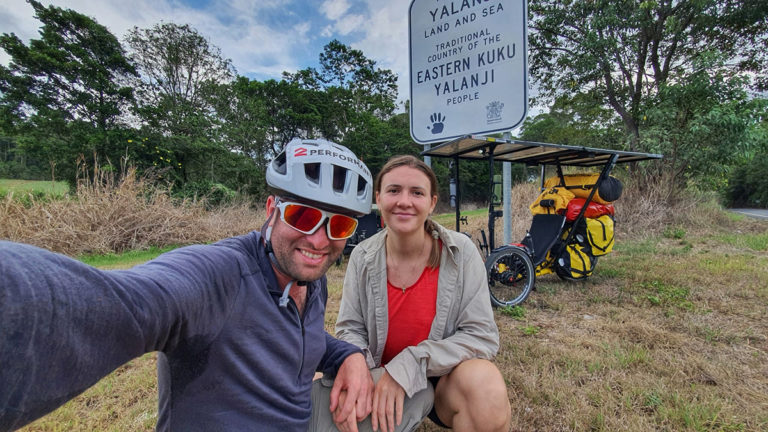
Cairns to Daintree
Our initial plan was to start riding from the northernmost point of continental Australia, Cape York, southwards, but as we were looking for means to get up to the Cape with all our equipment, we run into a dead end. No boats or trucks were able to take us that far up. So, in the end, we decided to ride northwards instead, all the way from Cairns. Cycling the iconic Cape York Peninsula, means you have to go up and down, anyways, but we only wanted to cycle it one way and save some energy for the rest of our long journey around Australia. What motivates me, personally to go on such long bike journeys is usually the novelty of the road and landscape, not knowing what’s around the corner. So, going back and fourth on the same road was not a very appealing idea to me.
We chose the coastal route from Cairns. Not the shortest and definitely not the easiest, but it allowed us to cycle alongside the Coral Sea, home of the famous Great Barrier Reef and through some of the oldest patches of rainforest in the world situated in the Daintree National Park. So old that cassowaries, a remnant of the dinosaurs are still roaming around.
The very first bit of our journey, from Cairns to Port Douglas was probably one of the worst bits of them all. However, the view is simply amazing. It follows for most of the way the Coral Sea, home to the Great Barrier Reef. We had the blue clear waters of the Coral sea with its bouldery shores on the right hand side and the steep slopes of the Macalister Range on the left. This is where the lush rainforest covering parts of the Great Dividing Range meets the reef. But, this is also one of the worst roads I ever cycled on. There is absolutely no room for such a thing as a tricycle and the heavy traffic can literally kill you. Neither us, nor the drivers were happy about it. Australian drivers do not seem to be friendly at all towards cyclists. As one driver whom I met further down the road put it: “Good thing you weren’t thrown a thing or two at you for attempting to cycle on such a heavily trafficked narrow road”. Other cyclists we met later on confirmed such practices to us as being common around this part of the country. In the end, we were very lucky to have safely made it across.

We slept at Ellis Beach campsite on the first night of our journey, waking up to one of the most amazing tropical sunrises. Now we knew we were up to something. Actually, for the next month or so, we got used to waking up at sunrise and going to bed at sunset. The sun is so powerful around here that it wakes you up instantly. There is no way you can get by with sleeping in. You really start living by nature’s clock. You soon forget what day or time of the week it is. You get so absorbed by the day to day routine of the nomad life and your only reference becomes nature’s ways.
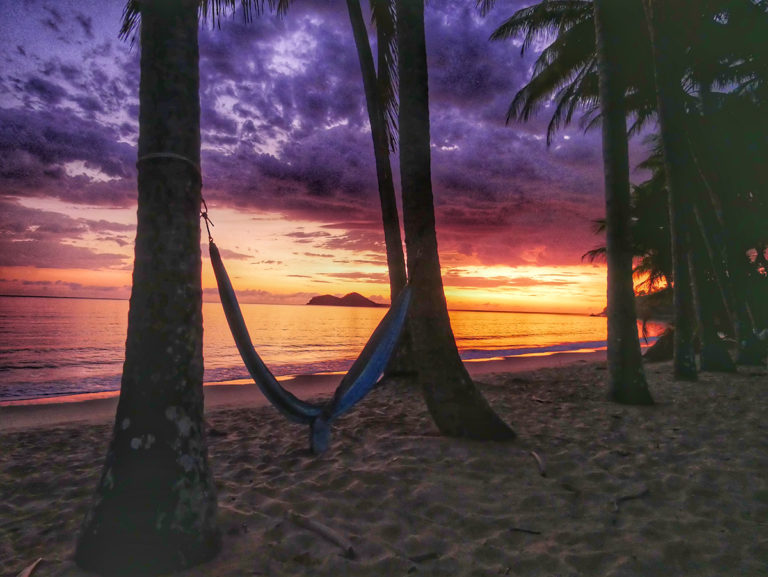
On our third day riding northwards the view opens up into the sugar cane fields that dominate most of the north east coast of Queensland, from around Rockhampton as far north as Mossman. However, on our second night of camping we had our tent eaten out by the ants, thus getting to known one of the fiercest living creatures inhabiting this part of the world. Not the snakes, not the spiders, but the freaking ants. I got so mad that they ate through the footprint and the floor of our brand new Big Agnes tent for which we paid $900. It’s the first time I get to patch a brand new tent only after a few days of use. And not just a hole or two, tens of them. It made the floor of our tent look like a colander. On the brighter side of things, Big Agnes decided to replace the main body of the tent with a new one after we insisted it’s not a normal thing to happen after only two nights or so of camping.
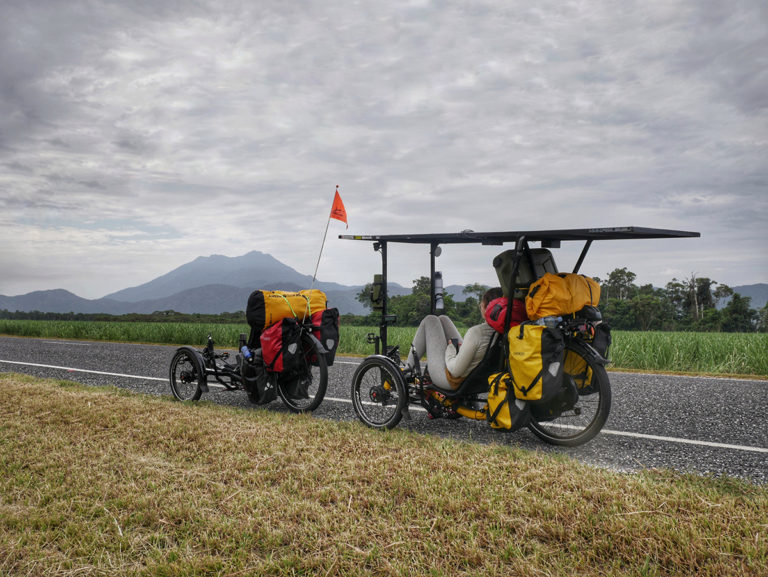
Daintree National Park
The Daintree River which is actually full of saltwater crocodiles, just like most other rivers around this part of Australia, doesn’t have bridge, so a ferry services the crossing. We got there at dusk and we were told by one of the workers (he actually insisted on us) that we camp about 5 kilometers up the road, in what loooked like a parking lot. This is because locals drive drunk at night and they speed up on the curvy uphill road linking the ferry to Cape Tribulation. We did listen to him and camped for the night and he actually came to check on us when his shift was over. I really think he cared about us and knowing already how crazy people drive around here, we thought it was a good idea to listen to him. We camped near Cape Kimberley and the Snapper Island, the place where Steve Irwin died back in 2003. A bandicoon paid us a visit during the night, intrigued by the smell of our month long food supplies. Moreover, this was the first time when we realised how many spiders surrounded our tent. If you switch off your headlamp at nighttime, tens of faded lights pop up, from the different species of spiders that live in the area. But, in the end, we got used to all the crazy wildlife surrounding us. In the end, this is Australia.
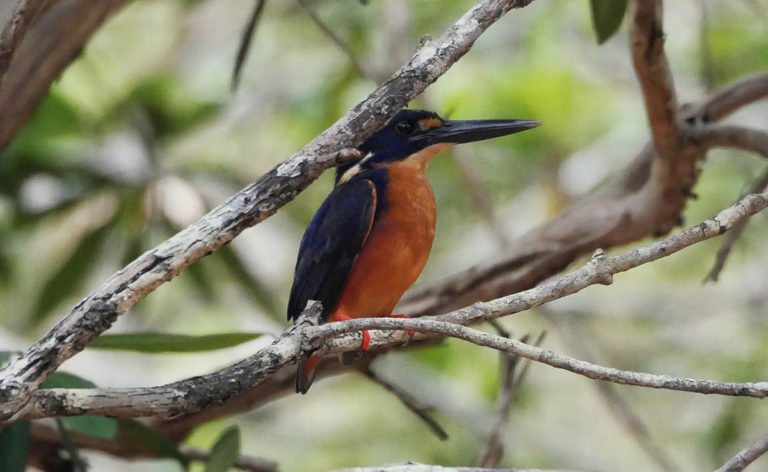
The coastal road through the Daintree National Park looks very much like a roller-coaster with curvy suddden steep ups and downs but the shade provided by the lush rainforest keeps the sun away, a rare luxury for most of our Cape York journey. Just before reaching Cape Tribulation, we stopped and had a fish and chips at a restaurant on the beach. This is when one of the truck drivers we met there, upon hearing of our plan to cycle up to Cape York on the (in)famous Peninsula Developmental Road, warned us to pay attention to the crazy truckers going up and down that road, he himself having hit a while ago a young Japanese lad riding a minibike. The Japanese adventurer turned up ok but his bike got completely destroyed and after the scare of it all, he will most probably keep away from riding on such roads in the future. This didn’t scare me though. Having cycled on different remote routes through the Americas did help me build confidence in handling such dangers.

Irina wasn’t used at all to riding her new solar trike and the tremendous hills and the poor quality of the road did’t help much. Her trike banked on the side and hit the ground three times because she did not have her weight balanced. The intermediary pulley got bent and the chain snapped due to the misuse of the gears going uphill. Not once, but twice. The second time it happened on the steepest of the steepest climbs of them all, on the infamous Donovan Range on the Bloomfield track. And if that was not enough, my rear wheel hub broke at the same time. If her problem was easily solvable, mine wasn’t. I had to buy a new rear wheel. Our journey was going bad at this stage, very bad. It looked as if we were never going to make it. We chose one of the hardest tracks as a starting point of our journey and everything seemed to go against us.
This is when we realised how self-sufficient and self-thought most people in remote places of Australia are. They learn to repair pretty much anything on their own. So it is not uncommon to find a proper workshop in the backyard of the locals. I had to buy a new wheel from Cairns but most of Irina’s problems could be solved on the spot. We eventually made it through and by the time we reached Cooktown we felt that we were finally making some progress and things were slowly falling into place for us.
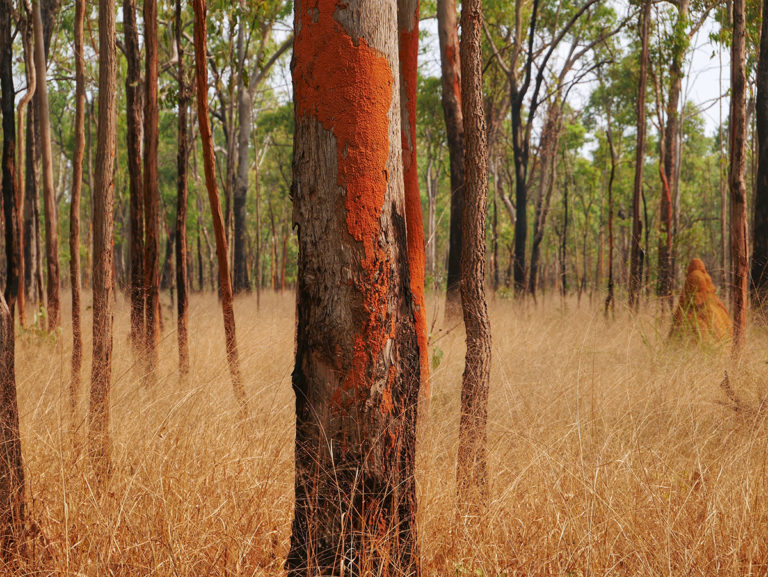
Cape York Peninsula
Cape York is considered by many one of the greatest remaining wildernesses of Australia. Situated between the Gulf of Carpentaria and the Coral Sea, even though most of the peninsula is flat, the eastern coast is stretched by the northern bit of the Great Dividing Range, which gave us all the trouble in the world in the first bit of our journey through the Daintree. What saved the peninsula from getting populated and developed is the poor quality of its soils, which meant that agriculture could not be pursued successfully in this area. This and the wet season that submerges most of the region between December and April of every year. Thus, most settlers decided to keep away. This is why, up until today, most of the peninsula, except a few cattle stations here and there, and a few indigenous towns, remains wild and untamed.
At Lion’s Den, an emblematic local pub situated near Cooktown, a local recommended us to take the Battle Camp Road that cuts across the Lakefield National Park, from Cooktown to Laura. The Lakefield National Park is known for its great endemic birds and wildlife and the road that goes through it provides an alternative to the southern end of the Peninsula Developmental Road. And, as we were told, at this time of the year, the red dirt road had just been graded by the road workers and the traffic on it was minimal. So, we went for it.
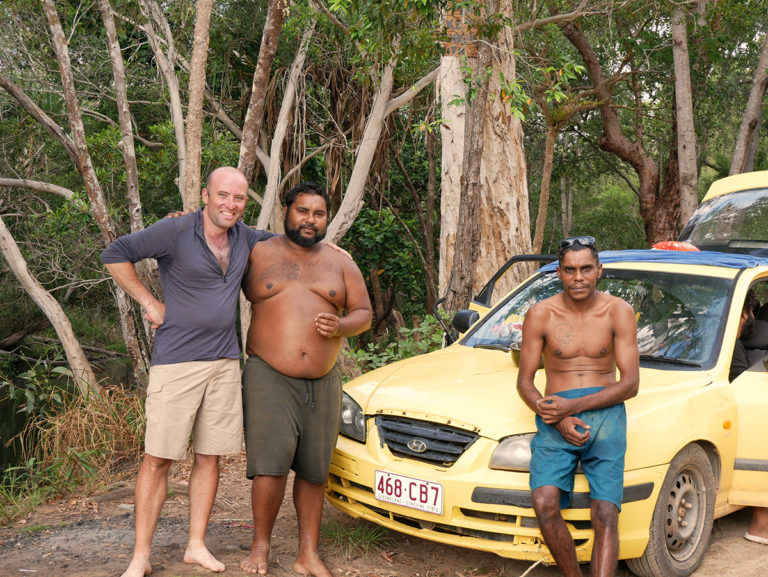
Soon after leaving Cooktown, we hit the red dirt road, which even though it felt like magic at first, it slowly, but surely, turned into a nightmare due to the heavy dust and the few fresh water sources along the way. We had a good night sleep in the campsite near the Normanby River. In the morning, we were mesmerised by the beauty of nature surrounding the river bed. It felt like we were back in Jurassic with the lush rainforest contrasting the eucalyptus and the paperbark trees dominating the open bush of the unending savannah. As a matter of fact, we realised that camping in or near the river beds, even though, most of those were bone dry at this time of the year, they still have a magic about them, attracting wildlife and humans alike.

Peninsula Developmental Road
The Peninsula Developmental Road is the only road linking Cape York to the rest of the country, stretching for hundreds of kilometres through the middle of the mostly uninhabited, dry and savannah dominated Cape York Peninsula. After a night slept in the Laura River bed which was bone dry, we found ourselves cycling on the (in)famous PDR (Peninsula Developmental Road). Some people compare it to the equally (in)famous Dalton Highway in Alaska, but, honestly speaking, having cycled on both, I would say this one is much more difficult to cycle on. This is mostly due to the corrugations and sandy areas, where we mostly had to get off our trikes and push our way through and nonetheless the heavy trucks overtaking us and literally covering us in a cloud of dust.
We chose to cycle the PDR in what was probably the hottest time of the year, the build-up before the wet season. On the one hand, this was a good choice, due to the fact that we avoided the tourist season when thousands flock to the Cape, and thus enjoying a minimal traffic on the road. On the other, we had to cycle for most of the time under terribly high temperatures, the highest average temperatures of the year. And under the threat of an early wet season, which meant that we could see ourselves locked in if the monsoon would make an early appearance. Given that during the wet season most of the roads in northern Australia become impracticable, this was a real threat. Fortunately, this was not the case for us. However, the heat was.

For the next two weeks, day in, day out, we had to battle the heat, the dust and the monotony of the road. We would try to start cycling as early as possible and have a lunch break in the early afternoon, but finding a shady place was quite an endeavour given that the eucalypts and the paperbark trees of the savannah do not provide much of a shade. Exhaustion from the heat and the effort soon took the best of us and we stopped having much of an appetite, eating less and less and we started loosing weight. We had to make sure we have enough water with us from one road house to the next, proper water management being of utmost importance in this part of the world. As I already mentioned, we were cycling in the dry season, which meant most rivers were dry. On one rare occasion, as we were approaching the northern tip of the peninsula, we were able to find a creek and a waterfall which seemed to have paid for all these hot days spent cycling in this hostile terrain. And no crocs were present (another danger omnipresent in the peninsula). So, we had the best swim of our journey so far, that is at Fruit Bat Falls.
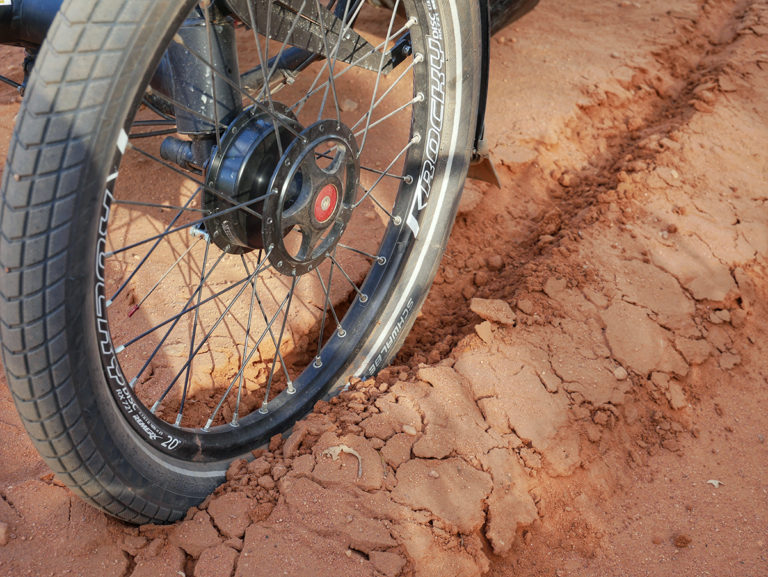
Against all odds, our trikes held on. Having embarked on this journey with a certain mistrust of Irina’s solar powered Ti Fly 26, we soon learned that our design was, in fact, able to cope with the roughest terrain of all. Sure, one of the welding points of the solar panels canopy broke, but, with the help of two locals, we were able to fix it and keep on riding. The good thing about starting a journey on such a hard road means that possible weaknesses do show up much faster than on easier roads and you know quite fast what needs to be improved and/or changed. If we are to make it around Australia and possibly back home to Europe on those, we would be better off knowing the soonest possible what can go wrong and what needs to be changed and how. I would not exaggerate to claim that Irina is the first person to have made it in a solar powered tricycle up to Cape York. Many people were surprised upon seeing her on this remote road on a solar powered tricycle. Sure, many people made it to the Cape on two wheeled pushbikes before. But, talking to locals, I do not think that anyone has made it yet on a solar powered tricycle. And to be honest, the Ti-Fly 26 was probably the best choice as the front and rear world class suspensions provide a smooth ride over the corrugated road and take off a lot of the pressure on the solar panels.

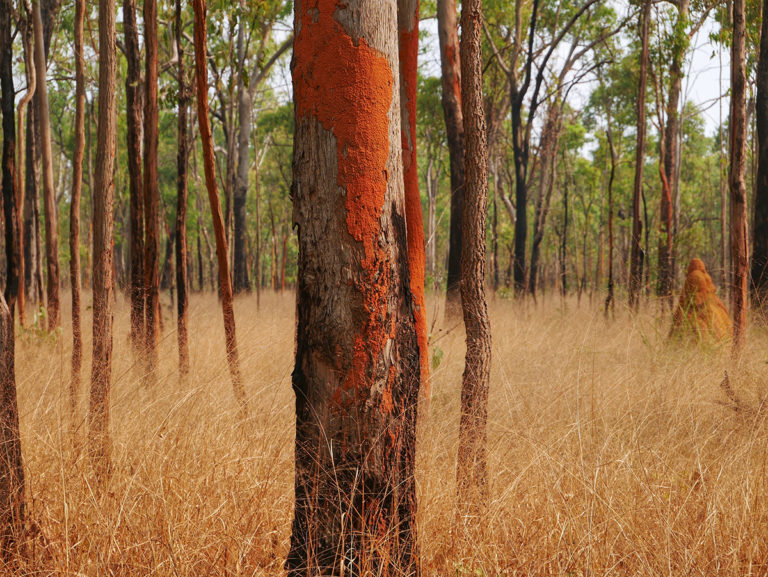

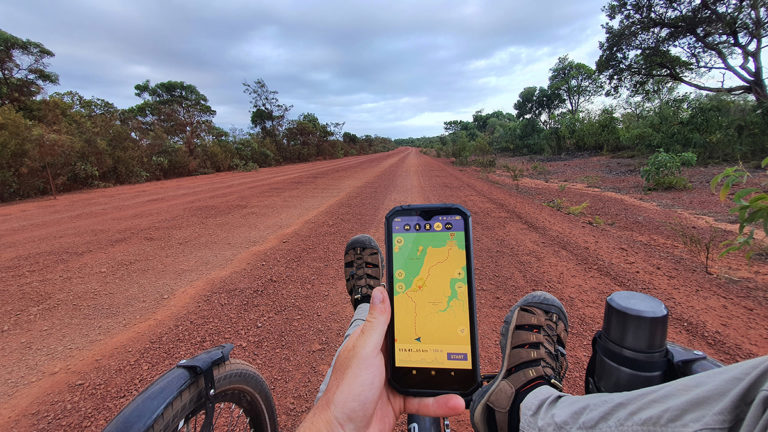
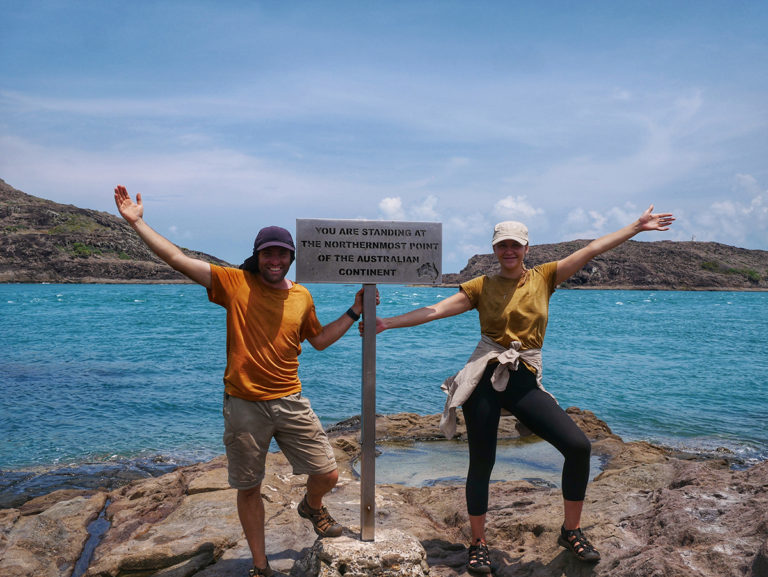
Our progress was a slow one. It took us one month and one day to cover roughly 1.200 kilometers from Cairns to the tip of Australia. But on November 14 2021, we made it to the northernmost point of continental Australia. Our progress was a slow one, through the dusty roads and tracks linking up the peninsula. This was a rough, wild and real introduction to the wilds of the land down under. This is real Australia, the tropical north with large stretches of aboriginal land barely touched. An area considered by many to be one of the last remaining great wildernesses of our planet; of great geographical variety and biodiversity.
The more we travel this land, the more it keeps on surprising us with its often bizarre and unexpectedly beautiful forms of live. At times I feel that parts of this area are stuck in a different era. It’s so old and yet so alive. So deep and so different from what I have seen and experienced so far. It’s dusty, it’s rough, it’s wild, but it is so beautiful.
As soon as we zip our tent and lay down on our comfy mattresses we can hear the most bizarre of sounds and noises. It’s a fairy tale land. So alive! So wild! So ancient! This is the continent where terrestrial life came into existence hundreds of millions years ago.
Against all odds and difficulties we can’t get enough of it. And this was just an epic beginning. There is so much more to see and experience.
(to be continued)
_____
This is the detailed list of all parts that were used in Irina’s trike conversion:
MAIN E-BIKE PARTS USED ON THE TRIKE
- Nine Continent Rear Cassette Motor, RH212 Model with Proper Bike Alignment, Statorade Ready, and L10 Connector. Standard 8.5 RPM/V Winding
- V3 Cycle Analyst
- Multifunction Switch for CA3-WP, with On/Off Power, Up/Down Digital Aux Buttons, and Screen Toggle with an additional extension cable
- Universal Lever Thumb Throttle with Clamp On Handlebar Mount 140 cm
- Pedal Sensor PAS Sensor with 24 Poles 120 cm length
- Brake Sensor Tripwire Pull Long
- TTL to USB Programming Cable for the Cycle Analyst
- Phaserunner Motor Controller
- 48 V 17.5Ah Panasonic Lithium Ion Battery
SOLAR PARTS OF THE RECUMBENT TRIKE
- 2 x 170 W Flexible SunPower SPR-E-Flex-170
- 2 x Genasun 8A MPPT 48V Voltage BOOST Controllers
- Anderson Connectors for the wiring
- Custom built canopy that supports the 2 solar panel

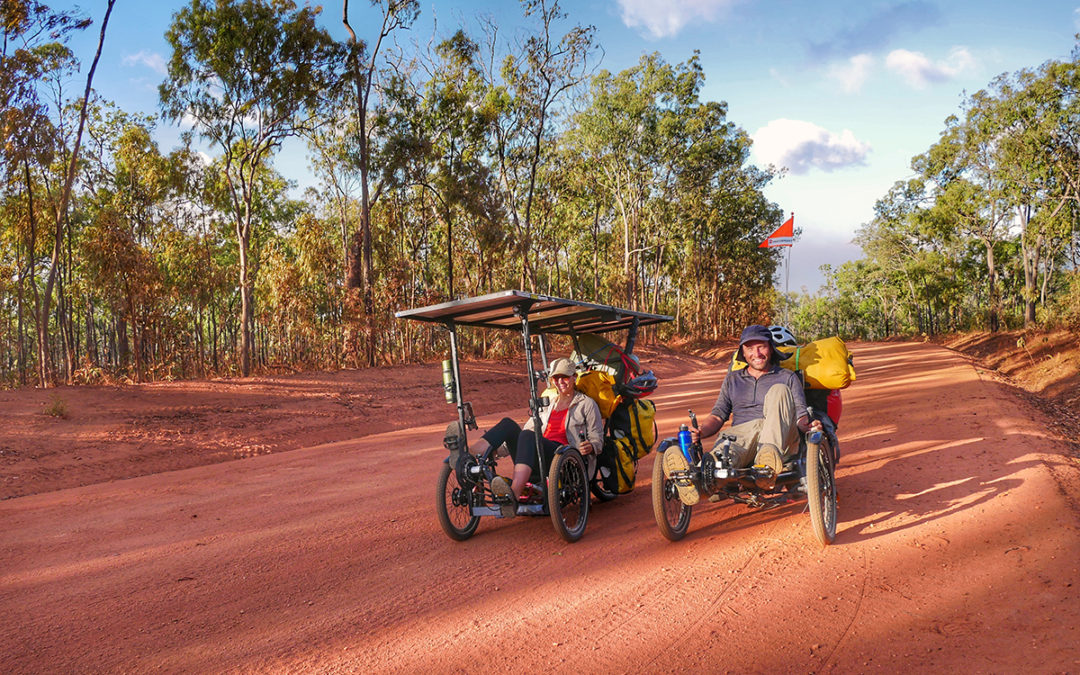

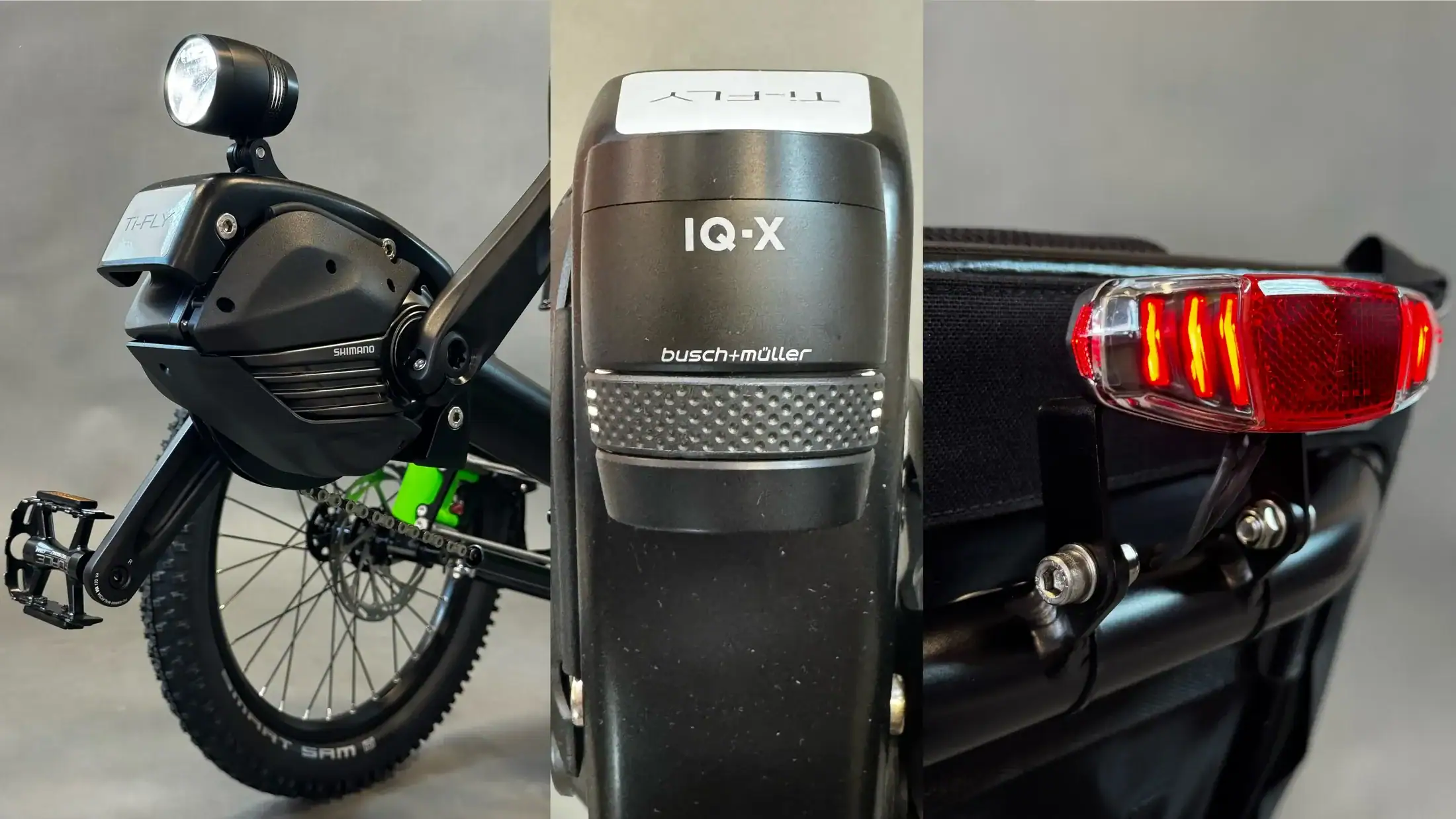

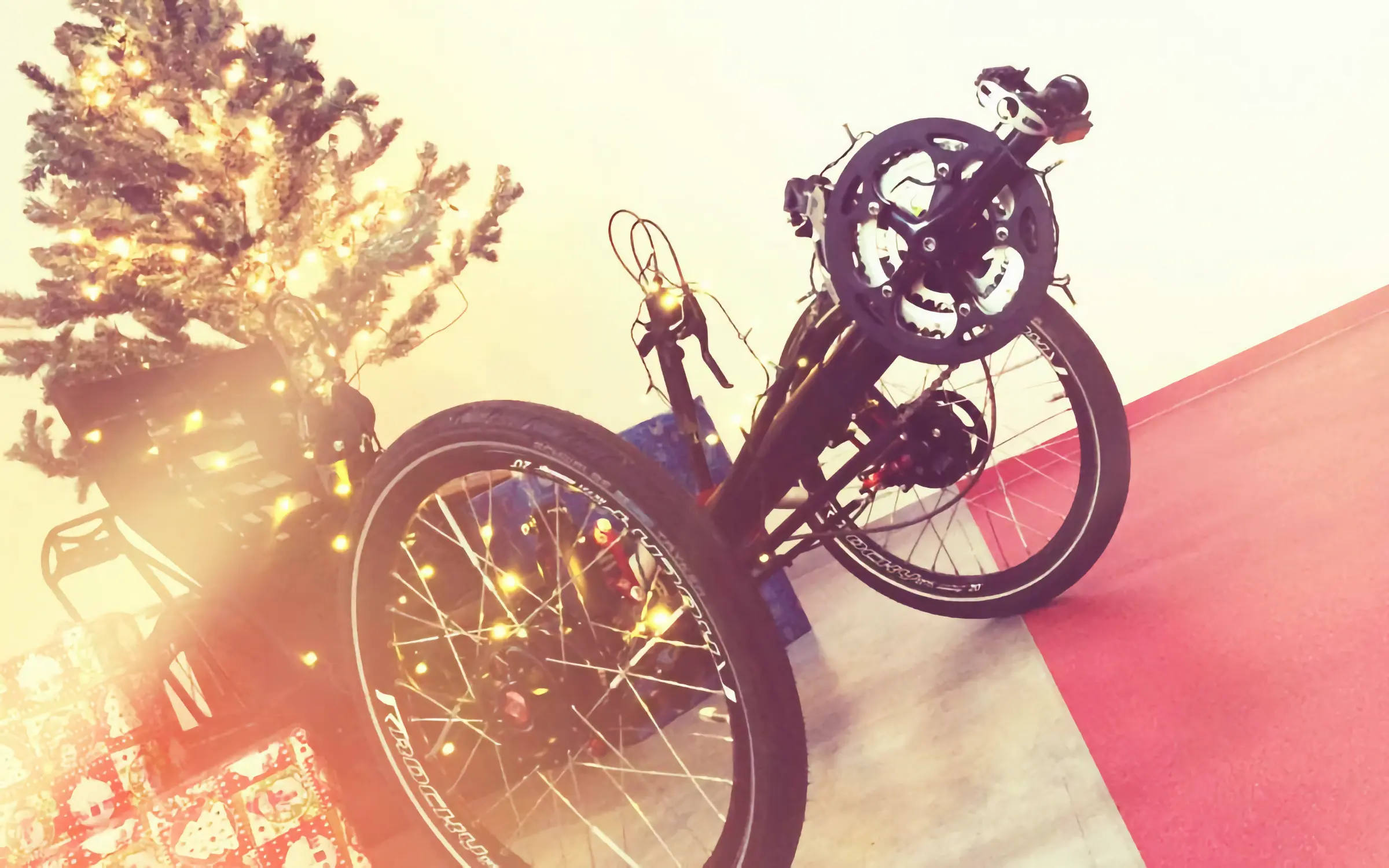
Join the worldwide group of AZUB fans
Get the latest stories, be inspired by our amazing builds and get some inside view.
You are close to join the fan group. Just see your inbox and confirm your e-mail address.